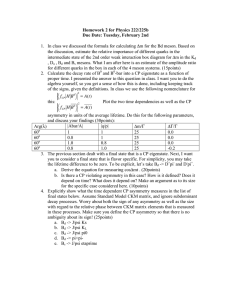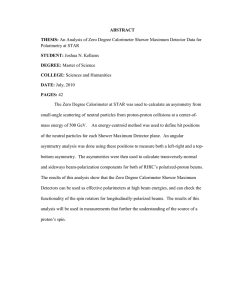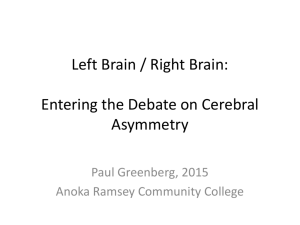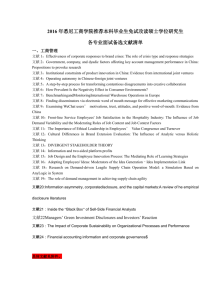Clipboard How asymmetrical before it’s asymmetrical?
advertisement
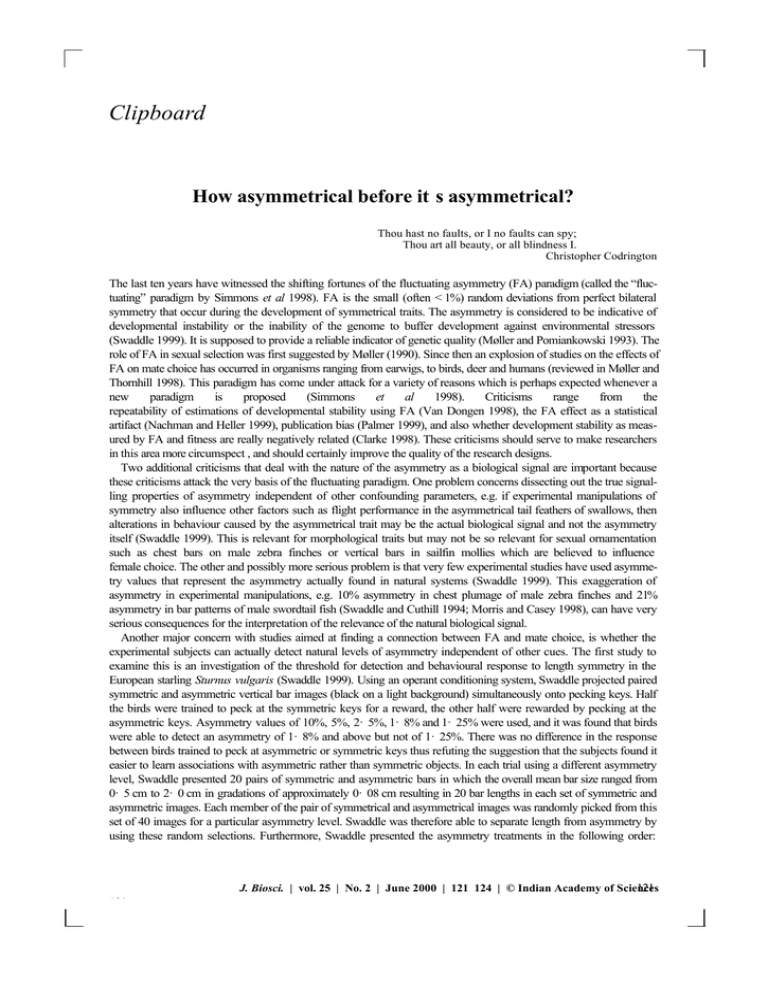
Clipboard How asymmetrical before it’s asymmetrical? Thou hast no faults, or I no faults can spy; Thou art all beauty, or all blindness I. Christopher Codrington The last ten years have witnessed the shifting fortunes of the fluctuating asymmetry (FA) paradigm (called the “fluctuating” paradigm by Simmons et al 1998). FA is the small (often < 1%) random deviations from perfect bilateral symmetry that occur during the development of symmetrical traits. The asymmetry is considered to be indicative of developmental instability or the inability of the genome to buffer development against environmental stressors (Swaddle 1999). It is supposed to provide a reliable indicator of genetic quality (Møller and Pomiankowski 1993). The role of FA in sexual selection was first suggested by Møller (1990). Since then an explosion of studies on the effects of FA on mate choice has occurred in organisms ranging from earwigs, to birds, deer and humans (reviewed in Møller and Thornhill 1998). This paradigm has come under attack for a variety of reasons which is perhaps expected whenever a new paradigm is proposed (Simmons et al 1998). Criticisms range from the repeatability of estimations of developmental stability using FA (Van Dongen 1998), the FA effect as a statistical artifact (Nachman and Heller 1999), publication bias (Palmer 1999), and also whether development stability as measured by FA and fitness are really negatively related (Clarke 1998). These criticisms should serve to make researchers in this area more circumspect , and should certainly improve the quality of the research designs. Two additional criticisms that deal with the nature of the asymmetry as a biological signal are important because these criticisms attack the very basis of the fluctuating paradigm. One problem concerns dissecting out the true signalling properties of asymmetry independent of other confounding parameters, e.g. if experimental manipulations of symmetry also influence other factors such as flight performance in the asymmetrical tail feathers of swallows, then alterations in behaviour caused by the asymmetrical trait may be the actual biological signal and not the asymmetry itself (Swaddle 1999). This is relevant for morphological traits but may not be so relevant for sexual ornamentation such as chest bars on male zebra finches or vertical bars in sailfin mollies which are believed to influence female choice. The other and possibly more serious problem is that very few experimental studies have used asymmetry values that represent the asymmetry actually found in natural systems (Swaddle 1999). This exaggeration of asymmetry in experimental manipulations, e.g. 10% asymmetry in chest plumage of male zebra finches and 21% asymmetry in bar patterns of male swordtail fish (Swaddle and Cuthill 1994; Morris and Casey 1998), can have very serious consequences for the interpretation of the relevance of the natural biological signal. Another major concern with studies aimed at finding a connection between FA and mate choice, is whether the experimental subjects can actually detect natural levels of asymmetry independent of other cues. The first study to examine this is an investigation of the threshold for detection and behavioural response to length symmetry in the European starling Sturnus vulgaris (Swaddle 1999). Using an operant conditioning system, Swaddle projected paired symmetric and asymmetric vertical bar images (black on a light background) simultaneously onto pecking keys. Half the birds were trained to peck at the symmetric keys for a reward, the other half were rewarded by pecking at the asymmetric keys. Asymmetry values of 10%, 5%, 2· 5%, 1· 8% and 1· 25% were used, and it was found that birds were able to detect an asymmetry of 1· 8% and above but not of 1· 25%. There was no difference in the response between birds trained to peck at asymmetric or symmetric keys thus refuting the suggestion that the subjects found it easier to learn associations with asymmetric rather than symmetric objects. In each trial using a different asymmetry level, Swaddle presented 20 pairs of symmetric and asymmetric bars in which the overall mean bar size ranged from 0· 5 cm to 2· 0 cm in gradations of approximately 0· 08 cm resulting in 20 bar lengths in each set of symmetric and asymmetric images. Each member of the pair of symmetrical and asymmetrical images was randomly picked from this set of 40 images for a particular asymmetry level. Swaddle was therefore able to separate length from asymmetry by using these random selections. Furthermore, Swaddle presented the asymmetry treatments in the following order: J. Biosci. | vol. 25 | No. 2 | June 2000 | 121–124 | © Indian Academy of Sciences 121 101 122 Clipboard 10%, 5%, 2· 5% and 1· 25%. On finding that there was a sharp drop in the proportion of correct responses at 1· 25%, Swaddle reasoned that it was possible that the birds were merely habituating to the presentation of stimuli and were no longer responding to perceptible asymmetry differences. He, therefore, immediately exposed the same birds to a new set of 10% asymmetric stimuli, and found that the symmetry detection immediately returned. Swaddle then continued with a set at 1· 8% asymmetry differences, and found that the asymmetry detection was nearly the same as at the 10% difference. He was therefore able to conclude that the threshold detection capability was somewhere between 1· 25 and 1· 8%. This finding corresponded well with earlier studies on the visual acuity of pigeons (Macko and Hodos 1985), possibly indicating general thresholds for the avian visual system. Swaddle cautions that his studies need to be refined using other types of visual patterns, such as random dot patterns and shape differences rather than vertical bar presentations, as it is possible that in the paired bars, the birds were responding to rectangular (paired symmetric bar patterns) versus irregular topologies (paired asymmetric bar patterns). Swaddle’s study is valuable because of the caveats that it generates. We need to know more about the perceptual systems of organisms before we infer connections between a signal and its evolution by sexual selection. Additionally the heritabilities of secondary sexual characters need to be investigated as also their links with developmental stability and reproductive success. According to Simmons et al (1998), the proportion of studies supporting a role of FA in sexual symmetry has declined steadily from 100% in the early part of the last decade to a current value of about 36%. These authors claim that this is because of an increasing improvement in methodologies and an increasing tightening up of experimental design. The “fluctuating paradigm” may come to rest at a stable point soon or may be completely discarded; it is early days yet. References Clarke G M 1998 Developmental stability and fitness: the evidence is not quite so clear; Am. Nat. 152 762–766 Macko K A and Hodos W 1985 Near point of accomodation in pigeons; Vision Res. 25 1529–1530 Møller A P 1990 Fluctuating asymmetry in male sexual ornaments may reliably reveal male quality; Anim. Behav. 40 1185–1187 Møller A P and Pomiankowski A 1993 Fluctuating asymmetry and sexual selection; Genetica 89 267–279 Møller A P and Thornhill R 1998 Bilateral symmetry and sexual selection: a meta-analysis; Am. Nat. 151 174–192 Morris M R and Casey K 1998 Female swordtail fish prefer symmetrical sexual signal; Anim. Behav. 55 33–39 Nachman G and Heller K E 1999 Fluctuating asymmetry as an index of fitness: causality or statistical artifact?; Oikos 86 357–365 Palmer A R 1999 Detecting publication bias in meta-analyses: a case study of fluctuating asymmetry and sexual selection; Am. Nat. 154 220–233 Simmons L W, Tomkins J L, Kotiaho and Hunt J 1998 Fluctuating paradigm; Proc. R. Soc. London B266 593–595 Swaddle J P 1999 Limits to length asymmetry detection in starlings: implications for biological signalling; Proc. R. Soc. London B266 1299–1303 Swaddle J P and Cuthill I C 1994 Female zebra finches prefer males with symmetric chest plumage; Proc. R. Soc. London B258 267–271 Van Dongen S 1998 How repeatable is the estimation of developmental stability by fluctuating asymmetry?; Proc. R. Soc. London B265 1423–1427 RENEE M BORGES Centre for Ecological Sciences, Indian Institute of Science, Bangalore 560 012, India (Email, renee@ces.iisc.ernet.in) J. Biosci. | vol. 25 | No. 2 | June 2000
